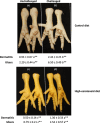Carotenoid-enriched transgenic corn delivers bioavailable carotenoids to poultry and protects them against coccidiosis
- PMID: 25846059
- PMCID: PMC11389004
- DOI: 10.1111/pbi.12369
Carotenoid-enriched transgenic corn delivers bioavailable carotenoids to poultry and protects them against coccidiosis
Abstract
Carotenoids are health-promoting organic molecules that act as antioxidants and essential nutrients. We show that chickens raised on a diet enriched with an engineered corn variety containing very high levels of four key carotenoids (β-carotene, lycopene, zeaxanthin and lutein) are healthy and accumulate more bioavailable carotenoids in peripheral tissues, muscle, skin and fat, and more retinol in the liver, than birds fed on standard corn diets (including commercial corn supplemented with colour additives). Birds were challenged with the protozoan parasite Eimeria tenella and those on the high-carotenoid diet grew normally, suffered only mild disease symptoms (diarrhoea, footpad dermatitis and digital ulcers) and had lower faecal oocyst counts than birds on the control diet. Our results demonstrate that carotenoid-rich corn maintains poultry health and increases the nutritional value of poultry products without the use of feed additives.
Keywords: Eimeria tenella; antioxidants; bioavailability; carotenoids; genetic engineering; poultry.
© 2015 Society for Experimental Biology, Association of Applied Biologists and John Wiley & Sons Ltd.
Figures





References
-
- Abbas, R.Z. , Iqbal, Z. , Khan, A. , Sindhu, Z.U.D. , Khan, J.A. , Khan, M.N. and Raza, A. (2012) Options for integrated strategies for the control of avian coccidiosis. Int. J. Agric. Biol. 14, 1014–1020.
-
- Arczewska‐Wlosek, A. and Świątkiewicz, S. (2012) The effect of a dietary herbal extract blend on the performance of broilers challenged with Eimeria oocysts. J. Anim. Feed Sci. 21, 133–142.
-
- Bai, C. , Twyman, R.M. , Farré, G. , Sanahuja, G. , Christou, P. , Capell, T. and Zhu, C. (2011) A golden era – pro‐vitamin A enhancement in diverse crops. In Vitro Cell Dev. Biol. Plant, 47, 205–221.
-
- Blount, J. , Metcalfe, N. , Birkhead, T. and Surai, P. (2003) Carotenoid modulation of immune function and sexual attractiveness in zebra finches. Science, 300, 125–127. - PubMed
-
- Castañeda, M.P. , Hirschler, E.M. and Sams, A.R. (2005) Skin pigmentation evaluation in broilers fed natural and synthetic pigments. Poult. Sci. 84, 143–147. - PubMed
Publication types
MeSH terms
Substances
LinkOut - more resources
Full Text Sources

